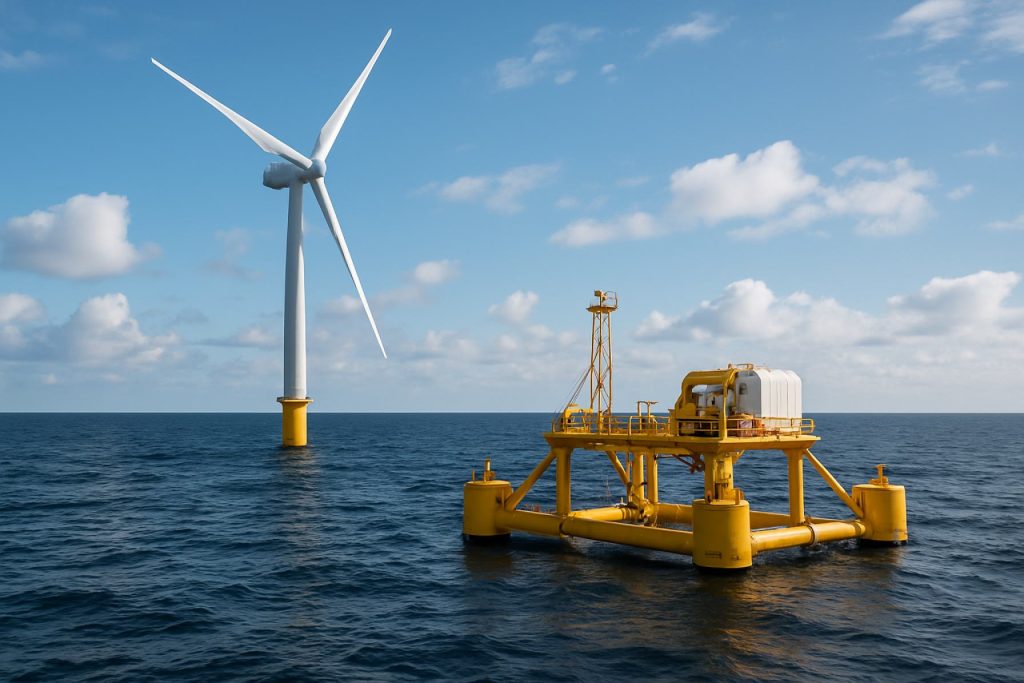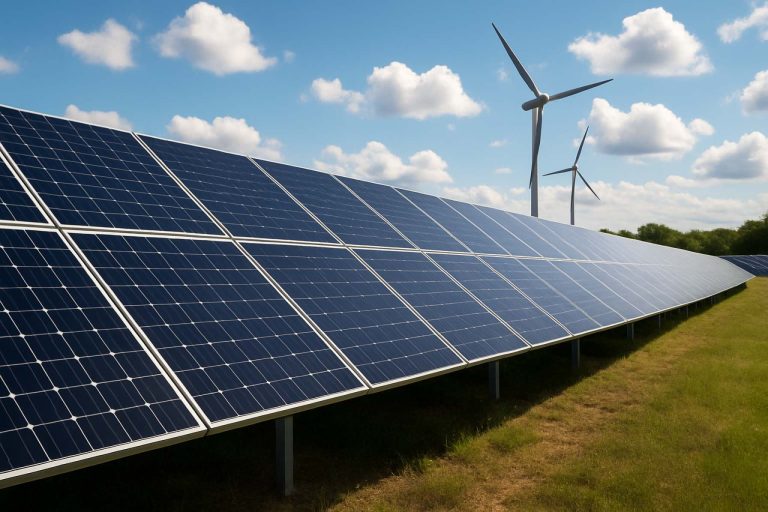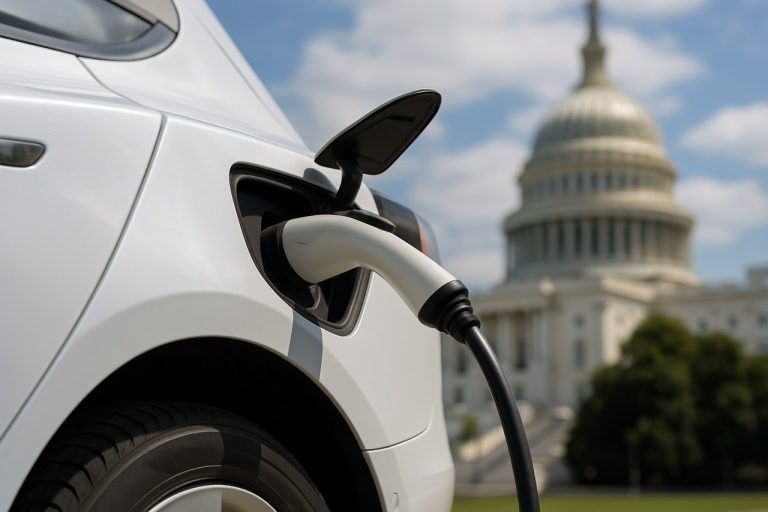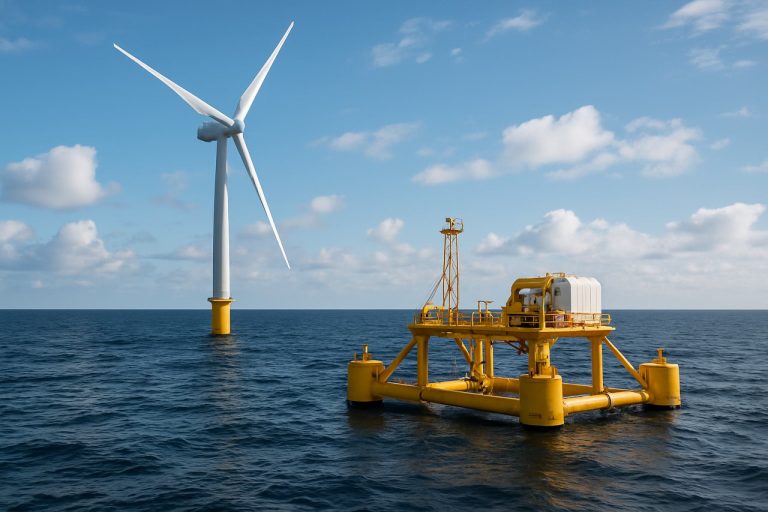
Offshore & Marine Renewable Energy Solutions in 2025: Charting the Course for Rapid Expansion and Technological Breakthroughs. Discover How the Sector is Powering a Sustainable Future at Sea.
- Executive Summary: Key Trends and Market Drivers
- Global Market Size and 2025–2030 Growth Forecasts
- Policy, Regulation, and International Collaboration
- Offshore Wind: Turbine Innovations and Floating Platforms
- Marine Energy: Tidal, Wave, and Ocean Thermal Developments
- Supply Chain, Infrastructure, and Logistics Challenges
- Investment Landscape and Leading Industry Players
- Environmental Impact, Sustainability, and Community Engagement
- Digitalization, AI, and Remote Operations in Offshore Renewables
- Future Outlook: Opportunities, Risks, and Strategic Recommendations
- Sources & References
Executive Summary: Key Trends and Market Drivers
The offshore and marine renewable energy sector is entering a pivotal phase in 2025, driven by ambitious decarbonization targets, technological advancements, and expanding investment. Governments across Europe, Asia, and North America are accelerating policy support for offshore wind, floating wind, and emerging marine energy technologies, positioning the sector as a cornerstone of the global energy transition.
Offshore wind remains the dominant force, with global installed capacity expected to surpass 80 GW by the end of 2025, up from approximately 64 GW in 2023. Major players such as Siemens Gamesa Renewable Energy, Vestas, and GE Vernova are scaling up next-generation turbine platforms, with individual turbine ratings now exceeding 15 MW. These advancements are enabling larger, more efficient projects, particularly in deepwater locations previously considered unviable.
Floating offshore wind is transitioning from demonstration to commercial scale, with significant projects underway in the UK, France, Norway, and Asia-Pacific. Companies like Equinor and Principle Power are leading the deployment of floating foundations, unlocking vast wind resources in deeper waters. The sector is expected to reach over 2 GW of installed floating wind capacity by 2025, with a robust pipeline for the latter half of the decade.
Marine energy technologies—including tidal stream, wave, and ocean thermal—are also gaining momentum, though at a smaller scale. Organizations such as Orbital Marine Power and SIMEC Atlantis Energy are advancing tidal stream projects, while wave energy developers are progressing through pilot and pre-commercial phases. The European Union and national governments are providing targeted funding to accelerate commercialization and grid integration.
Key market drivers include rising demand for clean electricity, energy security concerns, and the need for grid stability as variable renewables expand. Supply chain localization, port infrastructure upgrades, and digitalization are also shaping the competitive landscape. Strategic partnerships between utilities, oil & gas majors, and technology providers—such as those involving Shell and TotalEnergies—are accelerating project delivery and innovation.
Looking ahead, the offshore and marine renewables sector is poised for sustained growth, with global capacity additions set to accelerate through 2030. Continued policy support, cost reductions, and cross-sector collaboration will be critical to realizing the sector’s full potential as a pillar of the future energy system.
Global Market Size and 2025–2030 Growth Forecasts
The global market for offshore and marine renewable energy solutions is entering a period of accelerated growth, driven by ambitious decarbonization targets, technological advancements, and increasing investment in sustainable energy infrastructure. As of 2025, the offshore wind sector remains the dominant force within this market, but other marine renewables—such as tidal, wave, and floating solar—are gaining momentum.
According to industry data, global installed offshore wind capacity surpassed 64 GW by the end of 2024, with projections indicating a rise to over 100 GW by 2030. This expansion is underpinned by large-scale projects in Europe, East Asia, and North America. Leading developers such as Ørsted, Siemens Gamesa Renewable Energy, and Vestas are spearheading multi-gigawatt installations, leveraging both fixed-bottom and floating wind technologies. The floating wind segment, in particular, is expected to see compound annual growth rates exceeding 30% through 2030, as commercial-scale projects move from demonstration to deployment.
Beyond wind, marine energy solutions are diversifying. Tidal and wave energy projects, while still at a nascent stage compared to wind, are advancing with support from governments and industry consortia. Companies like Sabella and SIMEC Atlantis Energy are deploying tidal stream turbines in Europe and Asia, with pilot arrays demonstrating increasing reliability and grid integration. The European Union and the UK have set specific targets for marine energy, aiming for several hundred megawatts of installed capacity by 2030.
Floating solar, or offshore photovoltaics, is also emerging as a complementary solution, particularly in regions with limited land availability. Firms such as Seaflex and Ocean Sun are developing mooring and platform technologies to enable large-scale floating solar farms in sheltered marine environments.
Looking ahead to 2025–2030, the global offshore and marine renewables market is forecast to grow at a double-digit annual rate, with total market value potentially exceeding $100 billion by 2030. This growth will be supported by continued cost reductions, supply chain expansion, and supportive policy frameworks in key markets. The sector’s outlook is further strengthened by the entry of oil & gas majors—such as Equinor and Shell—who are leveraging offshore expertise to accelerate renewable deployments. As a result, offshore and marine renewable energy solutions are poised to play a pivotal role in the global energy transition over the next five years and beyond.
Policy, Regulation, and International Collaboration
Policy, regulation, and international collaboration are pivotal in shaping the trajectory of offshore and marine renewable energy solutions as the sector accelerates in 2025 and beyond. Governments worldwide are intensifying their commitments to decarbonization, with offshore wind and emerging marine technologies (such as tidal and wave energy) at the forefront of national and regional energy strategies.
In the European Union, the European Union has set ambitious targets under its Offshore Renewable Energy Strategy, aiming for at least 60 GW of offshore wind and 1 GW of ocean energy by 2030, with a long-term vision of 300 GW of offshore wind and 40 GW of ocean energy by 2050. The EU’s regulatory framework, including the revised Renewable Energy Directive, is streamlining permitting processes and fostering cross-border grid integration, which is crucial for large-scale offshore projects. The North Seas Energy Cooperation (NSEC), involving nine EU countries and Norway, exemplifies international collaboration, focusing on joint planning and harmonized standards for offshore infrastructure.
The United Kingdom, a global leader in offshore wind, continues to expand its regulatory support through the Contracts for Difference (CfD) scheme, which guarantees fixed prices for renewable energy producers. The UK government has set a target of 50 GW of offshore wind by 2030, including up to 5 GW from innovative floating wind projects. The The Crown Estate and Crown Estate Scotland play central roles in leasing seabed rights and facilitating environmental assessments, ensuring that new projects align with marine spatial planning and biodiversity objectives.
In the United States, the Biden administration has set a goal of deploying 30 GW of offshore wind by 2030 and 15 GW of floating offshore wind by 2035. The Bureau of Ocean Energy Management (BOEM) is accelerating lease auctions and environmental reviews, while the Inflation Reduction Act provides long-term tax incentives for offshore and marine renewables. State-level initiatives, particularly in New York, New Jersey, and California, are fostering regional collaboration and supply chain development.
Asia-Pacific markets are also advancing rapidly. Japan, South Korea, and Taiwan have established clear regulatory pathways and international partnerships to scale offshore wind, with Japan targeting 10 GW by 2030 and South Korea aiming for 12 GW. China remains the world’s largest offshore wind market, with over 30 GW installed and further expansion supported by national policy and state-owned enterprises such as State Power Investment Corporation and Goldwind.
Looking ahead, international collaboration is expected to deepen, with organizations like the International Energy Agency and the International Renewable Energy Agency facilitating knowledge exchange, best practices, and joint research. Harmonizing technical standards, environmental safeguards, and grid interconnections will be critical to unlocking the full potential of offshore and marine renewables in the coming years.
Offshore Wind: Turbine Innovations and Floating Platforms
The offshore wind sector is experiencing rapid technological evolution, with turbine innovations and floating platform solutions at the forefront of expanding marine renewable energy capacity. As of 2025, the global offshore wind market is characterized by the deployment of ever-larger turbines, increased project scale, and the commercial maturation of floating wind technology.
Turbine manufacturers are pushing the boundaries of size and efficiency. Vestas has advanced its V236-15.0 MW turbine, which boasts a 236-meter rotor diameter and is designed for high-capacity factor performance in deepwater sites. Siemens Gamesa Renewable Energy is rolling out its SG 14-236 DD, a direct drive offshore wind turbine with a 14 MW rating and the ability to reach up to 15 MW with Power Boost. These next-generation turbines are being selected for major projects in Europe and Asia, enabling fewer turbines per project and reducing installation and maintenance costs.
Floating offshore wind is transitioning from demonstration to commercial scale, unlocking vast new areas for development in deeper waters. Equinor, a pioneer in floating wind, is scaling up its Hywind technology, which utilizes spar-buoy floating foundations. The Hywind Tampen project, operational since 2023, is the world’s largest floating wind farm and supplies renewable power to offshore oil and gas platforms in the North Sea. Principle Power is another key player, with its WindFloat platform deployed in multiple pilot and pre-commercial projects, including WindFloat Atlantic off Portugal.
The outlook for 2025 and beyond is robust. The Global Wind Energy Council projects that global offshore wind capacity will more than double by 2030, with floating wind expected to account for a growing share of new installations. The United Kingdom, France, South Korea, and the United States are all advancing large-scale floating wind tenders and demonstration projects. Ørsted, the world’s largest offshore wind developer, is investing in both fixed-bottom and floating wind, targeting gigawatt-scale projects in Europe, Asia-Pacific, and North America.
Key challenges remain, including supply chain constraints, port infrastructure upgrades, and the need for standardized floating platform designs. However, with continued innovation from leading manufacturers and developers, offshore wind—both fixed and floating—is set to play a central role in the global transition to marine renewable energy over the next several years.
Marine Energy: Tidal, Wave, and Ocean Thermal Developments
Marine energy—encompassing tidal, wave, and ocean thermal technologies—continues to gain momentum as a critical component of offshore and marine renewable energy solutions. As of 2025, the sector is transitioning from pilot projects to early commercial deployments, driven by technological advancements, supportive policy frameworks, and increasing investment in decarbonization.
Tidal energy remains the most mature among marine energy technologies. The United Kingdom, particularly Scotland, leads in tidal stream deployments, with companies such as SIMEC Atlantis Energy and Nova Innovation operating multi-turbine arrays in the waters off Orkney and Shetland. Nova Innovation’s Shetland Tidal Array has been delivering power to the grid since 2016, and in 2024-2025, the company is expanding its capacity and exploring international projects in Canada and France. SIMEC Atlantis Energy continues to operate the MeyGen project, the world’s largest tidal stream array, with plans for further expansion and integration with battery storage.
Wave energy, while less mature, is seeing significant progress. Pelamis Wave Power (now part of Siemens Energy) and OceanEnergy are among the key players. OceanEnergy’s OE35 device, deployed in the United States and Ireland, is one of the world’s largest floating wave energy converters, with ongoing trials and grid-connected demonstrations. In Portugal, AW-Energy is advancing its WaveRoller technology, targeting commercial-scale deployments in 2025 and beyond.
Ocean thermal energy conversion (OTEC) is at an earlier stage but is attracting renewed interest, particularly in tropical regions. Lockheed Martin has been involved in OTEC research and pilot projects, focusing on scalable solutions for island communities and military applications. In Japan, ITOCHU Corporation and partners are developing OTEC demonstration plants, aiming for commercial viability by the late 2020s.
Looking ahead, the outlook for marine energy is increasingly positive. The European Union’s Offshore Renewable Energy Strategy targets 40 GW of ocean energy by 2050, with interim milestones in 2030 and 2035. National governments are introducing dedicated support mechanisms, such as the UK’s Contracts for Difference (CfD) scheme, which now includes ring-fenced funding for tidal stream projects. As costs decline and supply chains mature, marine energy is expected to play a growing role in decarbonizing coastal and island grids, supporting energy security, and creating new export opportunities for technology providers.
Supply Chain, Infrastructure, and Logistics Challenges
The rapid expansion of offshore and marine renewable energy solutions—particularly offshore wind and emerging technologies like floating solar and tidal energy—has brought supply chain, infrastructure, and logistics challenges to the forefront in 2025. As governments and industry stakeholders accelerate deployment to meet ambitious decarbonization targets, the sector faces both bottlenecks and opportunities for innovation.
A primary challenge is the limited availability of specialized vessels and port infrastructure capable of handling the size and complexity of next-generation offshore wind turbines, which now routinely exceed 15 MW per unit. Leading turbine manufacturers such as Siemens Gamesa Renewable Energy and GE Vernova have announced new models with even larger components, intensifying demand for heavy-lift vessels and deepwater quays. However, the global fleet of installation vessels is not keeping pace, with only a handful of new builds expected to enter service by 2026, according to industry sources.
Port upgrades are underway in key markets. For example, Ørsted, a global leader in offshore wind development, is investing in port facilities in the US and Europe to support its growing project pipeline. Similarly, Vattenfall and RWE are collaborating with local authorities to expand marshalling and pre-assembly areas, but construction timelines and regulatory approvals remain hurdles.
The supply chain for critical components—blades, towers, cables, and substations—faces constraints due to limited manufacturing capacity and competition for raw materials. The global push for localization, especially in the US and Asia-Pacific, is prompting companies like Vestas to establish new factories closer to project sites, aiming to reduce lead times and transportation costs. However, this transition is complex, requiring skilled labor, new supplier networks, and alignment with local content requirements.
Logistics for floating offshore wind and marine energy devices introduce additional complexity. The assembly and towing of floating platforms, such as those developed by Equinor and Principle Power, demand new approaches to project staging and offshore installation. The sector is also exploring digitalization and advanced tracking to optimize supply chain visibility and resilience.
Looking ahead, the industry is expected to invest heavily in digital supply chain management, modular construction, and workforce training to address these challenges. Collaboration between developers, manufacturers, and port authorities will be critical to unlocking the full potential of offshore and marine renewables in the coming years.
Investment Landscape and Leading Industry Players
The investment landscape for offshore and marine renewable energy solutions is experiencing robust growth as global decarbonization targets and energy security concerns drive capital towards sustainable technologies. In 2025, the sector is characterized by a surge in both public and private investments, with a particular focus on offshore wind, floating wind, and emerging marine energy technologies such as tidal and wave power.
Offshore wind remains the dominant segment, attracting the majority of new investments. According to industry data, global offshore wind capacity is expected to surpass 80 GW by the end of 2025, with significant projects underway in Europe, Asia, and North America. Leading the charge are established energy majors and specialized renewable developers. Ørsted, headquartered in Denmark, continues to be a global leader, operating and developing large-scale offshore wind farms across Europe, the United States, and Asia-Pacific. The company’s portfolio includes both fixed-bottom and floating wind projects, reflecting the sector’s technological evolution.
Another key player, Equinor of Norway, has positioned itself at the forefront of floating offshore wind, leveraging its offshore oil and gas expertise. Equinor’s Hywind projects, including Hywind Scotland and Hywind Tampen, are pioneering commercial-scale floating wind, a technology critical for deeper waters and new markets. Similarly, RWE, a major German utility, is expanding its offshore wind footprint with projects in the UK, Germany, and the US, and is investing in next-generation turbine technologies and digitalization.
In the Asia-Pacific region, Copenhagen Infrastructure Partners (CIP) and Mingyang Smart Energy are notable for their rapid project development and technology deployment, particularly in China and Taiwan. Mingyang, a leading Chinese turbine manufacturer, is advancing large-scale offshore wind turbines and integrated floating solutions, supporting the region’s ambitious renewable targets.
Beyond wind, marine energy technologies are gaining traction. Companies like SIMEC Atlantis Energy and OceanEnergy are piloting tidal stream and wave energy devices, with demonstration projects in the UK, France, and Ireland. While these technologies are at an earlier stage of commercialization, increased investment and supportive policy frameworks in 2025 are expected to accelerate their deployment.
Looking ahead, the investment outlook for offshore and marine renewables remains strong, underpinned by government auctions, corporate power purchase agreements, and green finance instruments. The sector’s leading players are not only scaling up capacity but also driving innovation in floating platforms, digital asset management, and grid integration, setting the stage for continued expansion through the latter half of the decade.
Environmental Impact, Sustainability, and Community Engagement
Offshore and marine renewable energy solutions—primarily offshore wind, tidal, and wave energy—are increasingly recognized for their potential to deliver large-scale, low-carbon electricity while supporting environmental sustainability and community engagement. As of 2025, the sector is experiencing rapid growth, with global offshore wind capacity expected to surpass 80 GW, driven by major installations in Europe, Asia, and North America. Leading developers such as Ørsted, Siemens Gamesa Renewable Energy, and Vestas are at the forefront, deploying next-generation turbines and floating platforms to minimize seabed disturbance and expand into deeper waters.
Environmental impact assessments (EIAs) and ongoing monitoring are central to project development. Companies like Equinor and RWE have implemented advanced wildlife monitoring systems, including radar and acoustic sensors, to mitigate risks to marine mammals and birds. The use of floating wind technology, pioneered by Equinor’s Hywind projects, reduces the need for extensive seabed anchoring, thus lessening habitat disruption and enabling deployment in sensitive or deeper marine environments.
Sustainability initiatives are increasingly embedded in project lifecycles. Ørsted has committed to net-zero operations by 2025, integrating circular economy principles such as turbine blade recycling and responsible sourcing of materials. Siemens Gamesa Renewable Energy has developed fully recyclable wind turbine blades, with commercial deployment underway, aiming to address end-of-life challenges and reduce landfill waste.
Community engagement is a critical component, with developers establishing local supply chains, job training programs, and benefit-sharing schemes. For example, Vestas and RWE have partnered with coastal communities to support workforce development and ensure local economic participation. In the United States, the Bureau of Ocean Energy Management (BOEM) requires comprehensive stakeholder consultation and environmental justice considerations for all offshore wind projects, ensuring that local voices are integrated into planning and permitting processes.
Looking ahead, the sector is poised for further innovation in environmental mitigation, such as artificial reef creation and biodiversity enhancement around turbine foundations. The integration of digital monitoring, adaptive management, and transparent reporting will be essential to maintaining public trust and regulatory compliance. As offshore and marine renewables scale up, the industry’s commitment to minimizing ecological impacts and maximizing community benefits will be pivotal in achieving global climate and sustainability goals.
Digitalization, AI, and Remote Operations in Offshore Renewables
The offshore and marine renewable energy sector is undergoing a rapid transformation driven by digitalization, artificial intelligence (AI), and remote operations. As the industry scales up to meet ambitious global targets for offshore wind and marine energy deployment, these technologies are becoming central to improving efficiency, safety, and cost-effectiveness.
Digitalization is enabling real-time monitoring and predictive maintenance of offshore assets. Leading turbine manufacturers such as Siemens Gamesa Renewable Energy and Vestas have integrated advanced sensor networks and digital twins into their offshore wind turbines. These digital twins create virtual replicas of physical assets, allowing operators to simulate performance, predict failures, and optimize maintenance schedules. This approach is expected to reduce unplanned downtime and extend asset lifespans, which is critical as offshore wind farms move further from shore and into deeper waters.
AI-driven analytics are also being deployed to enhance operational decision-making. Companies like GE Vernova are leveraging machine learning algorithms to analyze vast datasets from turbines, substations, and marine conditions. These insights help operators optimize power output, anticipate weather-related disruptions, and coordinate vessel logistics more efficiently. In 2025 and beyond, the integration of AI is anticipated to further reduce the levelized cost of energy (LCOE) for offshore renewables, supporting the sector’s competitiveness.
Remote operations are becoming increasingly viable due to advances in connectivity and automation. ABB and Schneider Electric are providing digital platforms that enable remote monitoring and control of offshore substations and grid infrastructure. These solutions minimize the need for personnel to travel offshore, enhancing safety and reducing operational costs. The use of remotely operated vehicles (ROVs) and autonomous underwater vehicles (AUVs) for inspection and maintenance is also expanding, with companies such as Saab and Oceaneering International at the forefront of this technology.
Looking ahead, the convergence of digitalization, AI, and remote operations is expected to accelerate the deployment of floating wind and marine energy projects. As the industry moves into more challenging environments, these technologies will be essential for scaling up capacity, ensuring reliability, and meeting the evolving demands of the global energy transition.
Future Outlook: Opportunities, Risks, and Strategic Recommendations
The offshore and marine renewable energy sector is poised for significant expansion in 2025 and the years immediately following, driven by ambitious national targets, technological advancements, and increasing private sector investment. The global offshore wind market, in particular, is expected to see robust growth, with cumulative installed capacity projected to surpass 100 GW by 2025, up from approximately 64 GW in 2023. This surge is underpinned by large-scale projects in Europe, Asia, and North America, with leading developers such as Ørsted, Vattenfall, and RWE expanding their portfolios and entering new markets.
Floating offshore wind is emerging as a transformative technology, enabling deployment in deeper waters and expanding the geographic reach of offshore renewables. Companies like Equinor and Principle Power are at the forefront, with demonstration projects scaling up to commercial arrays. The first commercial-scale floating wind farms are expected to come online in the UK, France, and South Korea by 2026, signaling a shift from pilot to mainstream adoption.
Marine energy technologies—including tidal stream, wave, and ocean thermal energy—are also advancing, though at a slower pace. Notable players such as SIMEC Atlantis Energy and OceanEnergy are progressing with grid-connected tidal and wave projects, particularly in the UK and Ireland. The European Union continues to support these innovations through funding and policy frameworks, aiming for commercial viability by the late 2020s.
Opportunities in the sector are substantial. Offshore wind is increasingly seen as a cornerstone of decarbonization strategies, with governments setting higher targets and streamlining permitting processes. The integration of offshore renewables with green hydrogen production—pursued by companies like Siemens Gamesa Renewable Energy and Shell—offers new revenue streams and grid-balancing solutions. Additionally, supply chain localization and port infrastructure upgrades are creating jobs and stimulating regional economies.
However, risks remain. Supply chain bottlenecks, inflationary pressures, and competition for skilled labor could delay project timelines and increase costs. Environmental concerns, such as impacts on marine ecosystems and fisheries, require careful management and stakeholder engagement. Geopolitical tensions and regulatory uncertainty in emerging markets may also pose challenges.
Strategic recommendations for stakeholders include investing in R&D for next-generation turbines and floating platforms, fostering cross-sector partnerships, and advocating for stable policy frameworks. Early engagement with local communities and transparent environmental monitoring will be critical for maintaining public support and securing project approvals. As the sector matures, digitalization and data-driven asset management will further enhance operational efficiency and resilience.
Sources & References
- Siemens Gamesa Renewable Energy
- Vestas
- GE Vernova
- Equinor
- Principle Power
- Shell
- TotalEnergies
- Siemens Gamesa Renewable Energy
- Vestas
- Seaflex
- Ocean Sun
- Equinor
- Shell
- European Union
- Crown Estate Scotland
- Bureau of Ocean Energy Management
- International Energy Agency
- Pelamis Wave Power
- Siemens Energy
- AW-Energy
- Lockheed Martin
- ITOCHU Corporation
- Vattenfall
- Copenhagen Infrastructure Partners
- ABB
- Saab
- Oceaneering International



